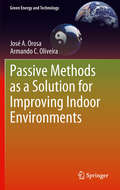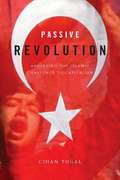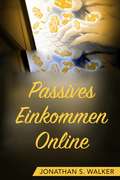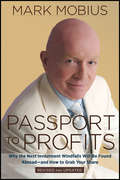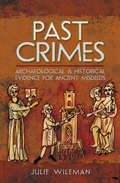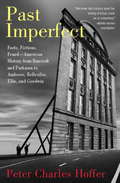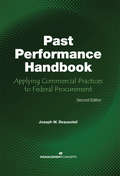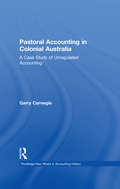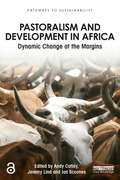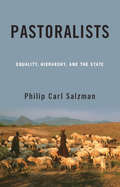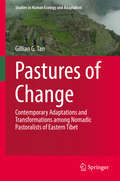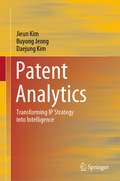- Table View
- List View
Passive House Details: Solutions for High-Performance Design
by Alison G. Kwok Donald B. Corner Jan C. FillingerPassive House Details introduces the concepts, principles, and design processes of building ultralow-energy buildings. The objective of this book is to provide design goals, research, analysis, systems, details, and inspiring images of some of the most energy-efficient, carbon-neutral, healthy, and satisfying buildings currently built in the region. Other topics included: heat transfer, moisture management, performance targets, and climatic zones. Illustrated with more than 375 color images, the book is a visual catalog of construction details, materials, and systems drawn from projects contributed from forty firms. Fourteen in-depth case studies demonstrate the most energy-efficient systems for foundations, walls, floors, roofs, windows, doors, and more.
Passive Income Ideas: 50 Ways to Make Money Online Analyzed
by Michael Ezeanaka<p>Michael Ezeanaka, provides a step-by-step analysis of 50 business models that have the potential to earn you passive income. A quick overview of each business is presented and their simplicity, passivity, scalability and level of competition in the marketplace are explored. <p>You'll learn something about each of these businesses. Best of all, you'll discover which particular business model suits your strengths and passion.</p>
Passive Methods as a Solution for Improving Indoor Environments
by José A. Orosa Armando C. OliveiraThere are many aspects to consider when evaluating or improving an indoor environment; thermal comfort, energy saving, preservation of materials, hygiene and health are all key aspects which can be improved by passive methods of environmental control. Passive Methods as a Solution for Improving Indoor Environments endeavours to fill the lack of analysis in this area by using over ten years of research to illustrate the effects of methods such as thermal inertia and permeable coverings; for example, the use of permeable coverings is a well known passive method, but its effects and ways to improve indoor environments have been rarely analyzed. Passive Methods as a Solution for Improving Indoor Environments includes both software simulations and laboratory and field studies. Through these, the main parameters that characterize the behavior of internal coverings are defined. Furthermore, a new procedure is explained in depth which can be used to identify the real expected effects of permeable coverings such as energy conservation and local thermal comfort as well as their working periods in controlling indoor environments. This theoretical base is built on by considering future research work including patents and construction indications which will improve indoor environmental conditions with evidence from real data. This makes Passive Methods as a Solution for Improving Indoor Environments an ideal resource for specialists and researchers focusing on indoor air quality, thermal comfort, and energy saving or with a general interest in controlling indoor environments with passive methods.
Passive Revolution
by Cihan TuğalIslamism in Turkey has been undergoing a significant transformation of rationalization and partial secularization that has been the result of the mobilization of broad sectors under the banner of radicalizing Islam, the subsequent defeat of radicalism, and the radicals' internalized strategic change after the defeat. So argues Tugal (sociology, U. of California at Berkeley), who details this process in Istanbul's district of Sultanbeyli, previously a stronghold of radicals, and relates the change to the fortunes of the recently established conservative party, the Justice and Development Party (AKP). He employs the Gramscian concept of "passive revolution" in order to analyze the process whereby popular sectors are mobilized with revolutionary discourses and strategies only to reinforce existing patterns of domination. In the case of the Islamist passive revolution, erstwhile radicals and their followers have been brought into the fold of neoliberalism, secularism, and Western hegemony. Annotation ©2009 Book News, Inc. , Portland, OR (booknews. com)
Passives Einkommen Online
by Jonathan S. WalkerLernen Sie die Geheimnisse, wie Sie noch heute online ein passives Einkommen generieren und Geld verdienen, dass für Sie arbeitet! Haben Sie es satt, sich wie ein Hund abzuarbeiten und ständig im Hamsterrad zu laufen? Haben Sie genug davon, täglich Zeit zu opfern, um Geld zu verdienen, auf Kosten Ihrer Freunde und Familie, wodurch Sie nie Ihre Zeit mit Ihren Geliebten verbringen zu können? Was, wenn ich Ihnen sage, dass es eine Möglichkeit gibt, online ein passives Einkommens-Imperium zu erschaffen, ohne Ihre Arbeit kündigen zu müssen? Würden Sie zuschlagen? Online Passives Einkommen ist die Lösung all Ihrer Probleme. Um derjenige zu sein, auf den ALLE eifersüchtig sind, müssen Sie HEUTE mit dem Aufbau Ihres Passiven Einkommens beginnen. Es braucht Zeit, bis ein neues Geschäft wächst und dieses Buch zeigt Ihnen die genauen Schritte, die Sie zum Starten Ihrer Reise tätigen müssen. In diesem Buch lernen Sie: 5 Profitable Quellen, um passive Einkommensströme online zu erzeugen Spezifische Strategien, damit Ihr Unternehmen wächst Profitable und hohes Einkommen generierende Blogs zu erstellen Ein Geschäftsimperium zu erbauen und mit FBA zu verkaufen Eine Mitgliedschaftsseite zu erstellen Mit E-Books auf dem Amazon Kindle Store Geld zu verdienen Einen profitablen Youtube Kanal einzurichten Die Resultate von online passiven Einkommen: Die Möglichkeit, die Welt zu bereisen Ihre Träume erfüllen Finanzielle Sicherheit haben Finanziell stressfrei sein Jederzeit kaufen, was immer Sie wollen Sie erhalten eine detaillierte Schritt für Schritt Anleitung für all die einzigartigen Strategien. Wagen Sie den Sprung ins Wasser mit all diesem Wissen in Ihrer Hand und werden Sie zu jemanden, der finanziell Frei ist und jeden Tag passives Einkommen kassiert? Jemand, der vor 40 in Rente geht und die Freiheit hat, sein
Passport to Profits
by Mark MobiusEmerging market investment advice from a seasoned pro Mark Mobius, the man the Wall Street Journal has proclaimed "the King of the Emerging Market Funds," spends eight months of the year traveling the globe in search of hidden market bargains overseas and in Passport to Profits: Why the Next Investment Windfalls Will be Found Abroad and How to Grab Your Share, Revised Edition, he shares what he's learned. In a globetrotting tour taking you from the Baltic coast to Brazil, Mobius reveals his own experience-tested guidelines for investing abroad. Analyzing companies and new markets, identifying potential pitfalls and overlooked values, crunching numbers and meeting the local players, he knows where true growth is, and with this book in hand, you will too. Presenting a straightforward, practical investment philosophy based on one key, indisputable fact: that the rest of the world's economies have far more potential for growth than our own, Passport to Profits shows even the most casual investor how to view investing abroad, how to devise a global investment strategy, and the pros and cons of buying individual stocks or mutual funds. The development of stock market infrastructures in emerging economies has opened up potential for impressive returns, and this book is your guide to cashing in. Illustrates the four keys to determining if a country is investment-friendly and how to gauge political climates for great investment opportunities Analyses the 2008 crisis and its implications for the development of the emerging financial markets Explains the rules for investing abroad that too many investors fail to understand An adventurous and honest insight into the art of investing in emerging international markets, Passport to Profits provides the hands-on experience you need to balance the risks and reap the rewards of global investing, right from the comfort of your home.
Past Crimes: Archaeological & Historical Evidence for Ancient Misdeeds
by Julie Wileman&“Presents an understanding of the science, skills, and craft of the archaeologist and how these can be used to unravel many criminal mysteries.&” —Police History Society Newsletter Today, police forces all over the world use archaeological techniques to help them solve crimes—and archaeologists are using the same methods to identify and investigate crimes in the past. This book introduces some of those techniques, and explains how they have been used not only to solve modern crimes, but also to investigate past wrongdoing. Past Crimes presents archaeological and historical evidence of crimes from mankind&’s earliest days, as well as evidence of how criminals were judged and punished. Each society has had a different approach to law and order, and these approaches are discussed here with examples ranging from Ancient Egypt to Victorian England—police forces, courts, prisons, and executions have all left their traces in the physical and written records. Also discussed here is how the development of forensic approaches has been used to collect and analyze evidence that were invented by pioneer criminologists. From the murder of a Neanderthal man to bank fraud in the nineteenth century, via ancient laws about religion and morality and the changes in social conditions and attitudes, a wide range of cases are included—some terrible crimes, some amusing anecdotes, and some forms of ancient law-breaking that remain very familiar.
Past Due: The End of Easy Money and the Renewal of the American Economy
by Peter S. GoodmanHow Main Street was hit by—and might recover from—the financial crisis, by The New York Times's national economics correspondentWhen the financial crisis struck in 2008, Main Street felt the blow just as hard as Wall Street. The New York Times national economics correspondent Peter S. Goodman takes us behind the headlines and exposes how the flow of capital from Asia and Silicon Valley to the suburbs of the housing bubble perverted America's economy. He follows a real estate entrepreneur who sees endless opportunity in the underdeveloped lots of Florida—until the mortgages for them collapse. And he watches as an Oakland, California-based deliveryman, unable to land a job in the biotech industry, slides into unemployment and a homeless shelter. As Goodman shows, for two decades Americans binged on imports and easy credit, a spending spree abetted by ever-increasing home values—and then the bill came due.Yet even in a new environment of thrift and pullback, Goodman argues that economic adaptation is possible, through new industries and new safety nets. His tour of new businesses in Michigan, Iowa, South Carolina, and elsewhere and his clear-eyed analysis point the way to the economic promises and risks America now faces.
Past Imperfect: Facts, Fictions, Fraud American History from Bancroft and Parkman to Ambrose, Bellesiles, Ellis, and
by Peter Charles HofferWoodrow Wilson, a practicing academic historian before he took to politics, defined the importance of history: "A nation which does not know what it was yesterday, does not know what it is today. " He, like many men of his generation, wanted to impose a version of America's founding identity: it was a land of the free and a home of the brave. But not the braves. Or the slaves. Or the disenfranchised women. So the history of Wilson's generation omitted a significant proportion of the population in favor of a perspective that was predominantly white, male and Protestant. That flaw would become a fissure and eventually a schism. A new history arose which, written in part by radicals and liberals, had little use for the noble and the heroic, and that rankled many who wanted a celebratory rather than a critical history. To this combustible mixture of elements was added the flame of public debate. History in the 1990s was a minefield of competing passions, political views and prejudices. It was dangerous ground, and, at the end of the decade, four of the nation's most respected and popular historians were almost destroyed by it: Michael Bellesiles, Doris Kearns Goodwin, Stephen Ambrose and Joseph Ellis. This is their story, set against the wider narrative of the writing of America's history. It may be, as Flaubert put it, that "Our ignorance of history makes us libel our own times. " To which he could have added: falsify, plagiarize and politicize, because that's the other story of America's history.
Past Performance Handbook: Applying Commercial Practices to Federal Procurement
by Joseph W. BeausoleilThe Best Guide to Past Performance Evaluation in Government Contracting Just Got Better!The Past Performance Handbook has long been the resource contracting professionals have turned to for guidance on evaluating contractor performance and making award decisions in competitive acquisitions based on the evaluation results.Now this essential resource has been completely updated and revised to bring readers the most up-to-date information they need to conduct past performance evaluations. Past Performance Handbook: Applying Commercial Practices to Federal Procurement, Second Edition, not only includes a detailed explanation of the process of past performance evaluation, but also presents new approaches to standardizing assessment areas and rating scales, streamlining the source selection process, and ensuring that awards are made to the most qualified offerors.This thoroughly revised second edition offers:• Additional focus on the collaboration between the government and contractors in providing past performance information• Enhanced definitions of numerical scoring, adjectival ratings, color coding schema, and risk assessments — all consistent with the current guidelines issued by the Department of Defense and the Office of Federal Procurement Policy (OFPP)• Updated citations from the Federal Acquisition Regulation, OFPP, and the Government Accountability Office (GAO)• Abridged GAO decisions that provide details for citations included in the text.Contracting officers and contractors working with the government will find value in every chapter of this updated edition.
Past and Present Migration Challenges: What European and American History Can Teach Us
by Francesca Fauri Debora MantovaniThis edited collection sheds light on the complex nature of migratory movements through the lens of economic and social history. It addresses a variety of migration issues involving Europe and the Americas in order to offer new insights on past and future migration and integration policies. The volume comprises multi-disciplinary research from both continents dealing with the economic, political, demographical and sociological impact of migration. This interdisciplinary approach aims to stimulate intellectual dialogue on the migration phenomenon among the international community of scholars in Europe and North and South America. It is divided into three parts, which offer an essential contribution to the issue of migration and aim at better understanding the effect that different forms of migration have had and will continue to exert on economic and social change in receiving countries. This book is a valuable resource for a wide audience including academics, students in the economic and social sciences, and government and EU officials working with migration topics.
Pastor As Person: Maintaining Personal Integrity In The Choices And Challenges Of Ministry
by Gary L. HarbaughHarbaugh captures your interest with dramatic stories of the inner lives of working pastors, weaving these stories into patterns of meaning from his own reflection and research. An excellent study guide for the individual pastor, the pastor's support group, or the seminary class that really wants to come to grips with the dilemmas of being a person who is also a pastor.
Pastoral Accounting in Colonial Australia: A Case Study of Unregulated Accounting (Routledge New Works in Accounting History)
by Garry CarnegieFirst Published in 1997. Routledge is an imprint of Taylor & Francis, an informa company.
Pastoralism and Development in Africa: Dynamic Change at the Margins (Pathways to Sustainability)
by Author UnknownOnce again, the Horn of Africa has been in the headlines. And once again the news has been bad: drought, famine, conflict, hunger, suffering and death. The finger of blame has been pointed in numerous directions: to the changing climate, to environmental degradation, to overpopulation, to geopolitics and conflict, to aid agency failures, and more. But it is not all disaster and catastrophe. Many successful development efforts at ‘the margins’ often remain hidden, informal, sometimes illegal; and rarely in line with standard development prescriptions. If we shift our gaze from the capital cities to the regional centres and their hinterlands, then a very different perspective emerges. These are the places where pastoralists live. They have for centuries struggled with drought, conflict and famine. They are resourceful, entrepreneurial and innovative peoples. Yet they have been ignored and marginalised by the states that control their territory and the development agencies who are supposed to help them. This book argues that, while we should not ignore the profound difficulties of creating secure livelihoods in the Greater Horn of Africa, there is much to be learned from development successes, large and small. This book will be of great interest to students and scholars with an interest in development studies and human geography, with a particular emphasis on Africa. It will also appeal to development policy-makers and practitioners.
Pastoralists: Equality, Hierarchy, and the State
by Philip Carl SalzmanDrawing upon the author's extensive field research among pastoral peoples in the Middle East, India, and the Mediterranean, and on more than 30 years of comparative study of pastoralists around the world, Pastoralists is an authoritative synthesis of the varieties of pastoral life. At an ethnographic level, the concise volume provides detailed analyses of divergent types of pastoral societies, including segmentary tribes, tribal chiefdoms, and peasant pastoralists. At the same time, it addresses a set of substantive theoretical issues: ecological and cultural variation, equality and inequality, hierarchy and the basis of power, and state power and resistance. The book validates "pastoralists" as a conceptual category even as it reveals the diversity of societies, subsistence strategies, and power arrangements subsumed by that term.
Pastures of Change: Contemporary Adaptations And Transformations Among Nomadic Pastoralists Of Eastern Tibet (Studies In Human Ecology And Adaptation Ser. #10)
by Gillian G. TanThis book offers a novel examination of socio-environmental change in a nomadic pastoralist area of the eastern Tibetan plateau. Drawing on long-term fieldwork that underscores an ethnography of local nomadic pastoralists, international development organisations, and Chinese government policies, the book argues that careful analysis and comparison of the different epistemologies and norms about "change" are vital to any critical appraisal of developments - often contested - on the grasslands of Eastern Tibet.Tibetan nomads have developed a way of life that is dependent in multiple ways on their animals and shaped by the phenomenological experience of mobility. These pastoralists have adapted to many changes in their social, political and environmental contexts over time. From the earliest historically recorded systems of segmentary lineage to the incorporation first into local fiefdoms and then into the Chinese state (of both Nationalist and Communist governments), Tibetan pastoralists have maintained their way of life, complemented by interactions with "the outside world".Rapid changes brought about by an intensification of interactions with the outside world call into question the sustained viability of a nomadic way of life, particularly as pastoralists themselves sell their herds and settle into towns. This book probes how we can more clearly understand these changes by looking specifically at one particular area of high-altitude grasslands in the Tibetan Plateau.
Patagonia
by Hyun Jin Kim Forest Reinhardt Ramon Casadesus-MasanellPatagonia produces high-quality environmentally friendly garments that command significant price premiums. Its environmental mission motivates it not only to donate to environmental causes and reduce the impact of its own production, but also to share its practices with other companies. While pursuing its strong environmental stance, Patagonia maintains a larger gross profit margin than its competitors and is targeting a 10% rate of annual growth in sales. In spring 2010, Patagonia was in the process of implementing a new, radical environmental initiative called "Product Lifecycle Initiative" (PLI). This initiative represented a holistic commitment to lengthen the lifecycle of each product and reduce landfill waste. It constituted Patagonia's efforts to take responsibility for the products it made, "from birth to death and then beyond death, back to rebirth." The initiative consisted of a mutual contract between the company and its customers to "reduce, repair, reuse, and recycle" the apparel that they consumed.
Patagonia (B)
by Forest Reinhardt Lauren Barley Ramon Casadesus-MasanellPatagonia produces high-quality environmentally friendly garments that command significant price premiums. In Spring 2010, Patagonia rolled out a new, radical environmental initiative called "Product Lifecycle Initiative" (PLI), which was committed to lengthening the lifecycle of each product and reducing landfill waste. This case provides an update on Patagonia's PLI as well as on other company environmental and social commitments.
Patas arriba, la escuela del mundo al revés
by Eduardo GaleanoHace cientotreinta años, después de visitar el país de las maravillas, Alicia se metió en un espejo para descubrir el mundo al revés. Si Alicia renaciera en nuestros días, no necesitaría atravesar ningún espejo: le bastaría con asomarse a la ventana. Al fin del milenio, el mundo al revés está a la vista: el mundo tal cual es, con la izquierda a la derecha, el ombligo a la espalda y la cabeza en los pies.
Patch Technology: Making It Easy To Do The Right Thing
by Robert J. Dolan Tomomichi Amano Carol ZhangCase
Patchwork Leviathan: Pockets of Bureaucratic Effectiveness in Developing States
by Erin Metz McDonnellCorruption and ineffectiveness are often expected of public servants in developing countries. However, some groups within these states are distinctly more effective and public oriented than the rest. Why? Patchwork Leviathan explains how a few spectacularly effective state organizations manage to thrive amid general institutional weakness and succeed against impressive odds. Drawing on the Hobbesian image of the state as Leviathan, Erin Metz McDonnell argues that many seemingly weak states actually have a wide range of administrative capacities. Such states are in fact patchworks sewn loosely together from scarce resources into the semblance of unity.McDonnell demonstrates that when the human, cognitive, and material resources of bureaucracy are rare, it is critically important how they are distributed. Too often, scarce bureaucratic resources are scattered throughout the state, yielding little effect. McDonnell reveals how a sufficient concentration of resources clustered within particular pockets of a state can be transformative, enabling distinctively effective organizations to emerge from a sea of ineffectiveness.Patchwork Leviathan offers a comprehensive analysis of successful statecraft in institutionally challenging environments, drawing on cases from contemporary Ghana and Nigeria, mid-twentieth-century Kenya and Brazil, and China in the early twentieth century. Based on nearly two years of pioneering fieldwork in West Africa, this incisive book explains how these highly effective pockets differ from the Western bureaucracies on which so much state and organizational theory is based, providing a fresh answer to why well-funded global capacity-building reforms fail—and how they can do better.
Patent Analytics: Transforming IP Strategy into Intelligence
by Jieun Kim Buyong Jeong Daejung KimThrough the prisms of a data scientist, a patent attorney, and a designer, this book demystifies the complexity of patent data and its structure and reveals their hidden connections by employing elaborate data analytics and visualizations using a network map. This book provides a practical guide to introduce and apply patent network analytics and visualization tools in your business. We incorporate case studies from renowned companies such as Apple, Dyson, Adobe, Bose, Samsung and more, to scrutinise how their underlying values of patent network drive innovation in their business. Finally, this book advances readers’ perspective of patent gazettes as big data and as a tool for innovation analytics when coupled with Artificial Intelligence.
Patent Assertion Entities and Competition Policy
by Sokol D. DanielPatent Assertion Entities (commonly known as 'patent trolls') hurt competition and innovation. This book, the first to analyze the most salient issues related to Patent Assertion Entities around the world, integrates economic theory with economic and legal reality to examine how the entities function and their impact on competition. It also offers legal and policy solutions that might be used to combat them. Edited by D. Daniel Sokol, the volume collects chapters from an array of leading scholars who describe Patent Assertion Entities in the United States, Europe, Korea, Taiwan, Japan, and China, while offering empirical accounts of the entities' economic consequences and their use of litigation as a means of legal extortion against many of the most innovative companies in the world, from startups to multinationals. It should be read by anyone interested in how Patent Assertion Entities operate and how they might be stopped.
Patent Intermediaries: 'New' Actors in the Intellectual Property Market
by Mario Benassi Miryam Martin-SanchezIntellectual property rights are a key element in today's knowledge economy. Specifically, the use of patents as transactional elements has become widespread. However, the market for patents possesses specific features that differentiate it from other markets. This book provides evidence for its existence and addresses its particular conditions. It also takes a deep dive into patent intermediaries, discussing how they emerged, their activity and business models, as well as their impact on market structure, firms, and societies. Patent intermediaries participate in market transactions by offering various services and by bridging supply and demand of patents. In the last decades, some of them (so-called pejoratively ‘patent trolls’) have become popular for their aggressive litigiousness. However, the activity and presence of patent intermediaries are much more significant. To enhance our understanding of the role of patent intermediaries, the authors provide a comprehensive review of the role of these agents in the Economy.
Patent It Yourself
by David Pressman Attorney Thomas J. TuytschaeversAttorney David Pressman and updater Thomas Tuytschaevers takes you through the entire patent process, providing scrupulously updated information and clear instructions to help you: determine if you can patent your invention understand patent law evaluate the commercial potential of your idea perform your own patent search file a provisional patent application prepare a formal patent application respond to patent examiners amend an application enforce and maintain your patent market and license your invention Thoroughly updated to reflect the latest changes in intellectual property law, this edition provides the latest U.S. Patent and Trademark Office rules and forms. It includes up-to-date discussions of the new "first to file" rule, which has to revolutionized patent law.


